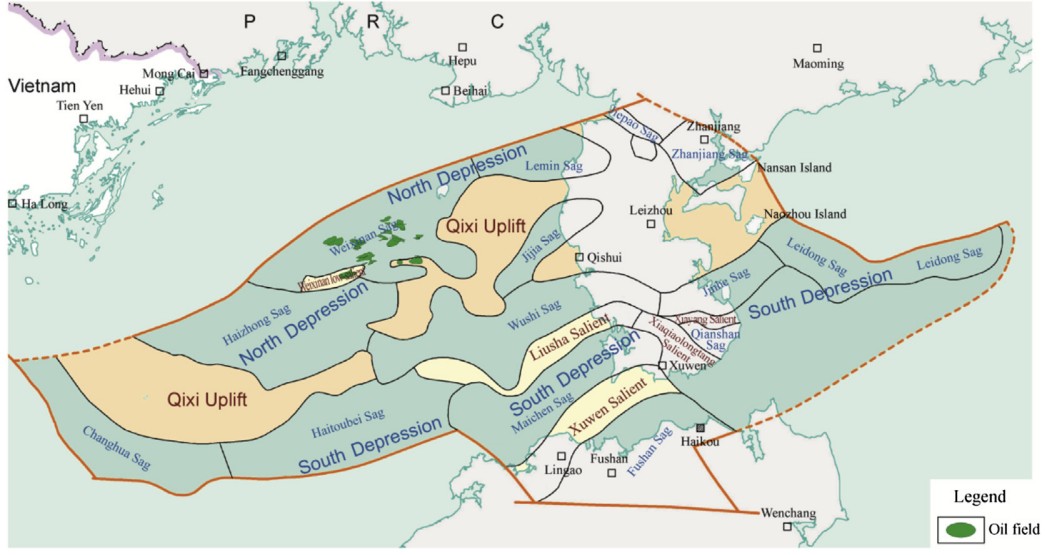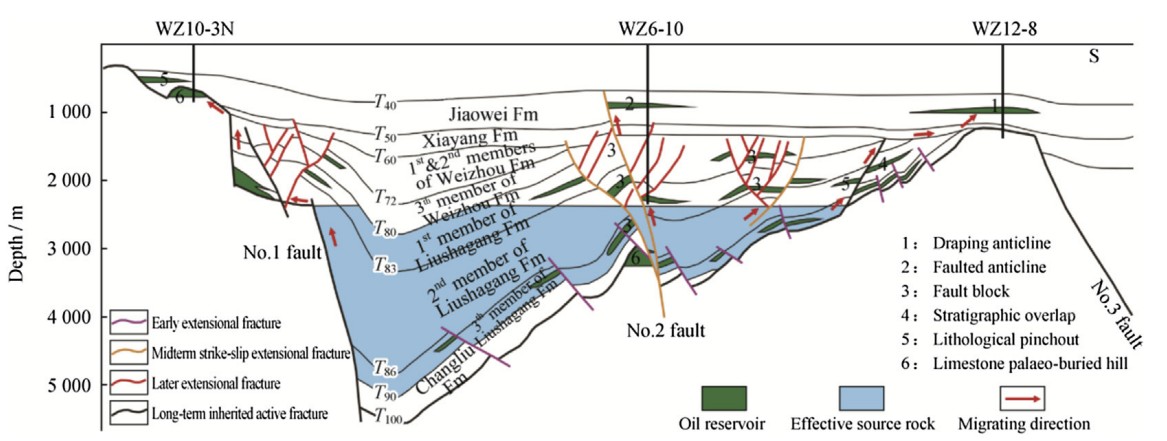
Тип бассейна:
Подтип бассейна:
Класс бассейна:
Возраст бассейна:
Тип полезных ископаемых:
Геологический возраст начало:
Геологический возраст конец:
Площадь: 33159.76 км²
Beibu Gulf Basin
The Beibu Gulf Basin, lying in the west part of the north continental shelf in the South China Sea, has experienced Paleogene fault subsidence, Neogene and Quaternary depression and neotectonic movement. The secondary units in the basin include three depressions and two uplifts, i.e. north depression, the Qixi Uplift, central depression, south uplift and south depression, and tertiary tectonic units include more than ten sags and salients (Figs. 1 and 2). These sags are further separated into sub-sags which are the basic hydrocarbon-generating units, and most of which feature thick Paleogene and thin Neogene.

Fig. 1. Distribution of oil fields in the Beibu Gulf Basin
The source rocks there are composed of medium-deep lacustrine mudstone in the Eocene Liushagang Fm, which, with mainly sapropelic and sapropel hybrid-typed organic matters of high organic matter abundance, represent high-quality source rocks, but vary widely in distribution in various sub-sags. The Beibu Gulf Basin is a hydrothermal basin with a geothermal gradient and heat flow value of 32.9 ± 7.10C/km and 65.7 ± 8.9 mW/m2 respectively. Source rocks of the second member of Liushagang Fm primarily generate oil due to the low thermal evolution degree, with Ro ranging from 0.2% to 1.2%. Therefore, some sags in the basin, i.e. the Weixi'nan Sag (composed of three sub-sags), the Fushan Sag and the east sub-sag of the Wushi Sag, have been proved to be oil-rich due to the joint effect of source and heat. Vertically oil exists in the Carboniferous palaeo-buried hill assemblage, the lower assemblage of the Paleocene Changliu Fm and the Eocene Liushagang Fm, the middle assemblage of the Oligocene Weizhou Fm, and the upper assemblage of the Neogene Xiayang Fm and Jiaowei Fm. Most parts of the basin have experienced weak neotectonic movement since the Neogene Period and petroleum accumulated near or within source beds. So far petroleum discoveries in the basin mainly have been concentrated in the middle and lower assemblages.

Fig. 2. Geologic section showing hydrocarbon accumulations in the Weixi'nan Sag, the Beibu Gulf Basin
The exploration of the Beibu Gulf Basin began in the 1970s and bloomed after the 1980s. All oil fields discovered are multiple oil and gas reservoirs due to complex Paleogene fractures. So far, more than ten oil fields have been discovered in the basin with proved oil reserves of hundreds of millions of tons, and no independent gas reservoir with commercial value has been discovered yet, indicating that the basin is of an oil type.
Data source: Analysis of the orderly distribution of oil and gas fields in China based on the theory of co-control of source and heat. Zhang G.C., Jin Li, Lan Lei, Zhao Zhao. 2015
Следующий Бассейн: Pearl River Mouth